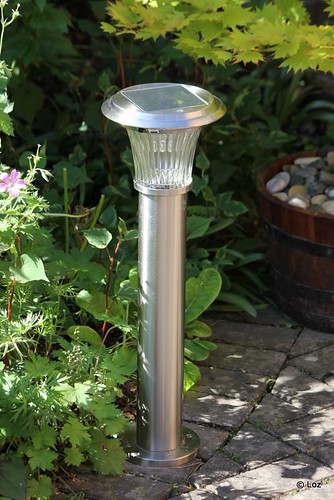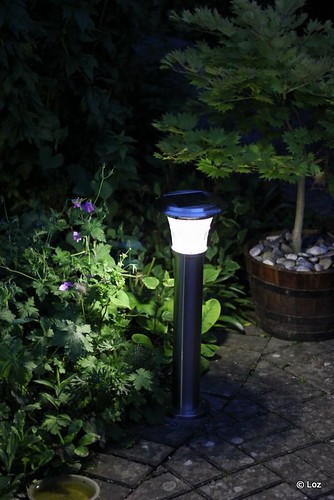Then I saw this comparison of solar lights in the Daily Telegraph. This suggested that recently "both solar panel technology and LED technology have proceeded at great speed", and singled out the Roma as being the best of the bunch and actually capable of replacing conventional powered lights. So I thought I would give them a try.
UPDATED: See comments at end re problems I have had with these lights.
I purchased them from Maplins as they had free delivery, and a voucher code at the time that saved me 10%.
Though at £49.99 each they are expensive for solar lights, the units are certainly very well constructed, made of marine grade stainless steel and glass.

As seen in the picture above, they are primarily designed to be screwed down onto a solid surface. Though some long nails are also provided to push into a softer surface for example into a lawn or border, these are pretty ineffectual and don't provide much stability.
The key difference between the Roma and other solar lights is the very large solar cell which is much larger than normal, and consequently gathers a lot more light and generates more electricity. Hence they can use a more powerful LED, and it lasts longer too.
So, what are they like in practice? Well, their performance is definitely well above the norm for solar. They are just as bright as the low-voltage halogen lights they replaced.

As you can see, they really do light up the surrounding area, not just the light itself. The lights do stay on a long time too. In fact I have no idea how long as I have gone to bed long before they have switched off (I think...).
However, it is now June in the northern hemisphere and the lights are getting as much daylight as is possible. How they will perform on short grey winter days is another matter, and I will report back on that. It is evident as you would expect that the less daylight they receive the shorter their operational hours. I already had to reposition a couple so that they were not in shade for parts of the day, which was reducing their hours. So, you can only position these lights were they are going to get full sunlight for all or at least most of the day. (though you can easily remove the head of the light with the solar panel, batteries and bulb, and put it somewhere else in the daytime to charge then move it back to its base that would normally be in shade all day - though that seems a bit extreme, but it is the sort of thing I have seen others recommend for optimising use of solar lights!)
The other downside is there is no control over when the lights come on or off, as this is done by a dusk sensor, and a timer that switches them off. However, neither can be adjusted. There is an on/off switch, but that means walking round all the lights each time - rather than flicking a single switch as you would normally do with conventional garden lights.
In the winter this means they are going to be coming on a something like 16.00, and probably going off at 18.00 as they will not have had sufficient daylight to power them for much longer. You could of course turn them off - they still charge whilst in the off position - and then turn them on later if you wished, but the operational hours are still going to be short. The only saving grace is I doubt I will want to spend much time in the garden in the evening, or even look at it much in the middle of winter...
I did also have a problem in that one of the lights was coming on a good hour and a half before the others, and subsequently switching off earlier than the rest too. With no way to adjust the sensor, my only recourse was to send it back for replacement - something Maplin handled very well BTW. It is likely that if you buy a set of lights they will all come on at slightly different times. Though a few minuites difference is acceptable, but not a few hours!
Overall though, they certainly live up to any claim to be the most powerful solar garden light, and during the spring, summer and autumn months will probably operate for a reasonable time. But I will be interested to see how well they fair in the winter.
UPDATE: Two years on since installing in summer 2010 and unfortunately I can't report that the lights have been without problems. The main problem is that whilst the stainless steel and glass parts of the lights may be weatherproof the switches and wiring are not. I found that by this summer (2012) the switches on half my lights had corroded and no longer switched. In one case, it had corroded so badly, that when wiggling it around trying to persuade the light to switch on the switch simply fell off! Also, some of the solar panels themselves appeared to be showing signs of corrosion.
Fortunately, I noticed these problems within the 2 year warranty period and the manufacturer did replace the 4 faulty units. However, I fully expect the worst and for the other 4 units to go the same way but then the manufacturer to claim they are outside the 2 year warranty and refuse to replace. At the price, I expect more than a 2 year life span.
Furthermore, I am still unable to locate any replacement batteries anywhere. I ended up in dispute with the sellers - Maplins - who had advertised them as using AA batteries, but they don't. They are totally proprietary and cannot be obtained anywhere other than from the manufacturer (who doesn't list them for sale on their website either). On the threat of sending the lights back on the basis they were not as advertised and not even Maplins themselves sold the batteries, I did persuade Maplins to get the manufacturer to send me a set of replacement batteries for the 4 remaining units the manufacturers had replaced. So at least battery wise I should be OK for another 2 years.
So whilst I can recommend these lights as the best performing on the market in terms of the light they produce, I can't say they are not without faults in the long-term. If you expect a £49 light to last longer than 2 years you might end up being disappointed.
No comments:
Post a Comment